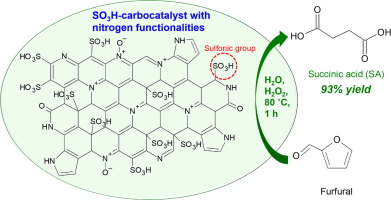当前位置:
X-MOL 学术
›
J. Colloid Interface Sci.
›
论文详情
Our official English website, www.x-mol.net, welcomes your feedback! (Note: you will need to create a separate account there.)
Oxidative upgrade of furfural to succinic acid using SO3H-carbocatalysts with nitrogen functionalities based on polybenzoxazine.
Journal of Colloid and Interface Science ( IF 9.9 ) Pub Date : 2020-01-03 , DOI: 10.1016/j.jcis.2020.01.001 Uthen Thubsuang 1 , Suphawadee Chotirut 1 , Kamchai Nuithitikul 1 , Apirak Payaka 2 , Nicharat Manmuanpom 3 , Thanyalak Chaisuwan 3 , Sujitra Wongkasemjit 3
Journal of Colloid and Interface Science ( IF 9.9 ) Pub Date : 2020-01-03 , DOI: 10.1016/j.jcis.2020.01.001 Uthen Thubsuang 1 , Suphawadee Chotirut 1 , Kamchai Nuithitikul 1 , Apirak Payaka 2 , Nicharat Manmuanpom 3 , Thanyalak Chaisuwan 3 , Sujitra Wongkasemjit 3
Affiliation

|
SO3H-carbocatalysts with nitrogen functionalities were prepared using the carbonization of polybenzoxazine derived from four different amines (aniline, ethylenediamine, triethylenetetramine, and tetraethylenepentamine) and then sulfonation. The obtained SO3H-carbocatalysts underwent catalytic testing for furfural oxidation with H2O2 to produce succinic acid. The effects of nitrogen functionalities were reported for the first time. The results showed that all carbon samples exhibited a microporous characteristic with comparable textural properties and contained various nitrogen functionalities (N-6, N-5, N-Q, and N-X). After sulfonation, the SO3H-carbocatalyst prepared from tetraethylenepentamine-based polybenzoxazine had the highest amount of sulfonic acid groups (1.45 mmol g-1) and a high nitrogen content (4.23%), providing a maximum succinic acid yield of 93.0% within a rapid reaction time of 60 min under the optimized conditions. This was higher than from Amberlyst-type catalysts and SO3H-carbocatalyst without nitrogen functionalities and was ascribed to the synergistic activity of the sulfonic acid groups and nitrogen functionalities. The XPS spectra and computational study confirmed that such nitrogen functionalities, especially N-5, are capable of forming hydrogen bonding with furfural, facilitating the formation of an intermediate compound and thereby enhancing the catalytic efficiency. However, after four cycles, the succinic acid yield decreased to 40% due to leaching of the sulfonic acid groups.
中文翻译:

使用基于聚苯并恶嗪的具有氮官能度的SO3H-碳氢化合物将糠醛氧化升级为琥珀酸。
使用由四种不同的胺(苯胺,乙二胺,三亚乙基四胺和四亚乙基五胺)衍生的聚苯并恶嗪碳化,制备具有氮官能团的SO3H-碳催化剂。对获得的SO3H-催化剂进行催化测试,以糠醛与H2O2氧化制得琥珀酸。首次报道了氮官能度的影响。结果表明,所有碳样品均表现出具有可比的质地特性的微孔特征,并包含各种氮官能团(N-6,N-5,NQ和NX)。磺化后,由四亚乙基五胺基聚苯并恶嗪制得的SO3H催化剂的磺酸基团数量最多(1.45 mmol g-1),氮含量高(4.23%),在优化条件下,在60分钟的快速反应时间内可提供93.0%的最大琥珀酸收率。这高于没有氮官能团的Amberlyst型催化剂和SO3H-碳氢化合物,并且归因于磺酸基团和氮官能团的协同活性。XPS光谱和计算研究证实,这样的氮官能团,尤其是N-5,能够与糠醛形成氢键,促进中间化合物的形成,从而提高催化效率。然而,在四个循环之后,由于磺酸基团的浸出,琥珀酸的产率降低至40%。这高于没有氮官能团的Amberlyst型催化剂和SO3H-碳氢化合物,并且归因于磺酸基团和氮官能团的协同活性。XPS光谱和计算研究证实,这样的氮官能团,尤其是N-5,能够与糠醛形成氢键,促进中间化合物的形成,从而提高催化效率。然而,在四个循环之后,由于磺酸基团的浸出,琥珀酸的产率降低至40%。这高于没有氮官能团的Amberlyst型催化剂和SO3H-碳氢化合物,并且归因于磺酸基团和氮官能团的协同活性。XPS光谱和计算研究证实,这样的氮官能团,尤其是N-5,能够与糠醛形成氢键,促进中间化合物的形成,从而提高催化效率。然而,在四个循环之后,由于磺酸基团的浸出,琥珀酸的产率降低至40%。它们能够与糠醛形成氢键,促进中间体化合物的形成,从而提高催化效率。然而,在四个循环之后,由于磺酸基团的浸出,琥珀酸的产率降低至40%。它们能够与糠醛形成氢键,促进中间体化合物的形成,从而提高催化效率。然而,在四个循环之后,由于磺酸基团的浸出,琥珀酸的产率降低至40%。
更新日期:2020-01-04
中文翻译:

使用基于聚苯并恶嗪的具有氮官能度的SO3H-碳氢化合物将糠醛氧化升级为琥珀酸。
使用由四种不同的胺(苯胺,乙二胺,三亚乙基四胺和四亚乙基五胺)衍生的聚苯并恶嗪碳化,制备具有氮官能团的SO3H-碳催化剂。对获得的SO3H-催化剂进行催化测试,以糠醛与H2O2氧化制得琥珀酸。首次报道了氮官能度的影响。结果表明,所有碳样品均表现出具有可比的质地特性的微孔特征,并包含各种氮官能团(N-6,N-5,NQ和NX)。磺化后,由四亚乙基五胺基聚苯并恶嗪制得的SO3H催化剂的磺酸基团数量最多(1.45 mmol g-1),氮含量高(4.23%),在优化条件下,在60分钟的快速反应时间内可提供93.0%的最大琥珀酸收率。这高于没有氮官能团的Amberlyst型催化剂和SO3H-碳氢化合物,并且归因于磺酸基团和氮官能团的协同活性。XPS光谱和计算研究证实,这样的氮官能团,尤其是N-5,能够与糠醛形成氢键,促进中间化合物的形成,从而提高催化效率。然而,在四个循环之后,由于磺酸基团的浸出,琥珀酸的产率降低至40%。这高于没有氮官能团的Amberlyst型催化剂和SO3H-碳氢化合物,并且归因于磺酸基团和氮官能团的协同活性。XPS光谱和计算研究证实,这样的氮官能团,尤其是N-5,能够与糠醛形成氢键,促进中间化合物的形成,从而提高催化效率。然而,在四个循环之后,由于磺酸基团的浸出,琥珀酸的产率降低至40%。这高于没有氮官能团的Amberlyst型催化剂和SO3H-碳氢化合物,并且归因于磺酸基团和氮官能团的协同活性。XPS光谱和计算研究证实,这样的氮官能团,尤其是N-5,能够与糠醛形成氢键,促进中间化合物的形成,从而提高催化效率。然而,在四个循环之后,由于磺酸基团的浸出,琥珀酸的产率降低至40%。它们能够与糠醛形成氢键,促进中间体化合物的形成,从而提高催化效率。然而,在四个循环之后,由于磺酸基团的浸出,琥珀酸的产率降低至40%。它们能够与糠醛形成氢键,促进中间体化合物的形成,从而提高催化效率。然而,在四个循环之后,由于磺酸基团的浸出,琥珀酸的产率降低至40%。



























 京公网安备 11010802027423号
京公网安备 11010802027423号